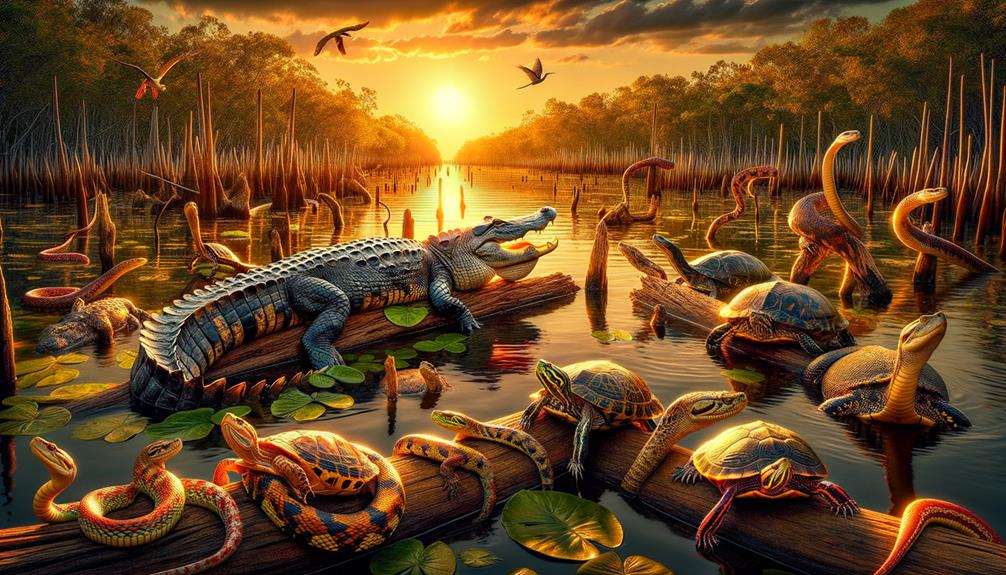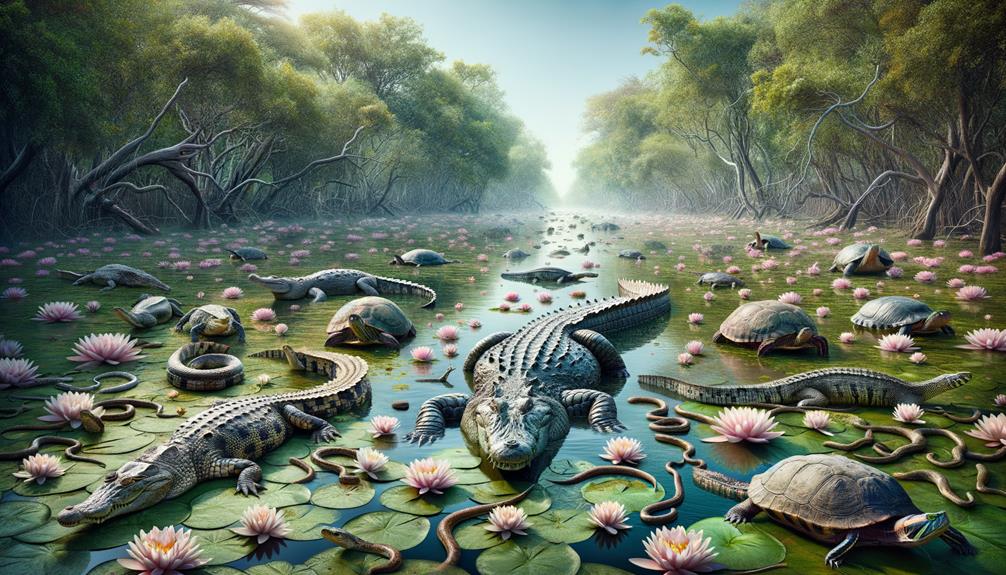I've delved into the reptilian riches of Kakadu, and they're truly astonishing. The giant saltwater crocodiles, known as 'salties,' rule the waterways, while their less aggressive freshwater cousins inhabit rivers and billabongs. With 36 species of snakes, including the venomous western brown snake and the nocturnal olive python, the park's biodiversity is remarkable. Turtles, such as the long-necked and snake-necked varieties, can live up to 50 years, adding to the park's ecological richness. Monitor lizards, like the yellow-spotted monitor, play a vital role in maintaining the ecosystem's balance. Each species in Kakadu has a unique role, ensuring the park's intricate web of life remains robust and dynamic. There's still much to uncover about these incredible creatures.
Key Takeaways
Kakadu is home to apex predators like saltwater and freshwater crocodiles, which play a vital role in maintaining the ecosystem's delicate balance.
The park boasts an impressive 36 species of land snakes, including venomous and nocturnal varieties, each contributing to the rich biodiversity.
Eleven turtle species, such as the northern long-necked and snake-necked turtles, perform crucial ecological functions within the park's unique environment.
Kakadu's diverse monitor lizard population features the yellow-spotted and mangrove monitors, among others, which are closely monitored for valuable insights into conservation and ecosystem health.
Conservation efforts involve careful tracking of reptile populations to gain a deeper understanding of the ecosystem's overall health and make informed conservation decisions.
Saltwater Crocodiles
In the heart of Kakadu National Park, massive saltwater crocodiles rule the wetlands and rivers. These enormous reptiles, which can grow over 6 meters long and weigh more than 1,000 kg, are the apex predators of the region. As I explored the park, I was awestruck by the sheer presence of these ancient creatures.
Locals call them 'salties,' and they're a testament to Kakadu's pristine natural environment. Their dominance is evident everywhere, from the murky rivers to the vast floodplains. These territorial and aggressive creatures often make headlines for their encounters with humans. To maintain a balanced ecosystem, their population is carefully monitored, ensuring both their survival and the safety of park visitors.
As I wandered through Kakadu, I developed a deep respect for these apex predators. Their existence highlights the park's untamed beauty and the delicate balance required to preserve such a unique habitat. Every crocodile sighting reminded me of the wild, untamed freedom that Kakadu National Park embodies.
Freshwater Crocodiles
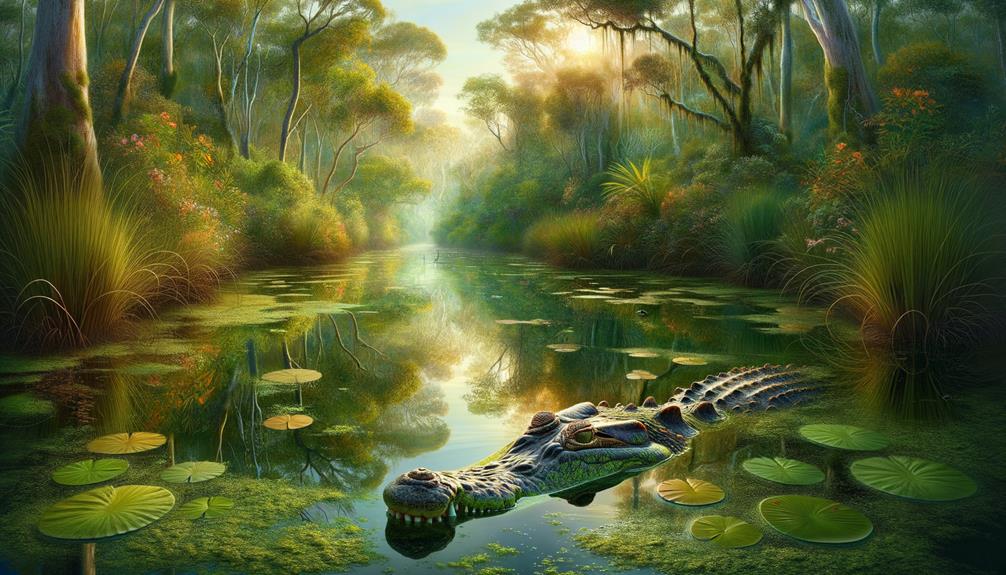
While saltwater crocodiles grab attention with their massive size and ferocity, Kakadu's freshwater crocodiles offer a unique contrast with their more subdued presence and distinct behaviors. These reptiles, which can grow up to three meters in length, primarily inhabit freshwater rivers, billabongs, and marshes in Kakadu National Park. Unlike their saltwater cousins, freshwater crocodiles are generally less aggressive and pose little threat to humans unless provoked.
One of the most delightful experiences in Kakadu is spotting these reptiles basking in the sun along the water's edge. They play a critical role in the wetland ecosystem, serving as apex predators and maintaining the balance of aquatic life. Despite their crucial ecological function, they are often overshadowed by their more notorious relatives.
Here's a quick comparison to highlight the differences between the two:
| Characteristic | Freshwater Crocodile (Crocodylus johnstoni) | Saltwater Crocodile (Crocodylus porosus) |
|---|---|---|
| Habitat | Freshwater rivers, billabongs, marshes | Coastal areas, estuaries, rivers |
| Maximum Length | Up to 3 meters | Up to 7 meters |
| Aggressiveness | Generally less aggressive | Highly aggressive |
| Human Threat Level | Low, unless provoked | High |
The freshwater crocodile populations in Kakadu are relatively stable, thanks to concerted conservation efforts. This ensures their continued presence in the park's waterways, allowing us to appreciate their unique charm and ecological importance.
Land Snakes Variety
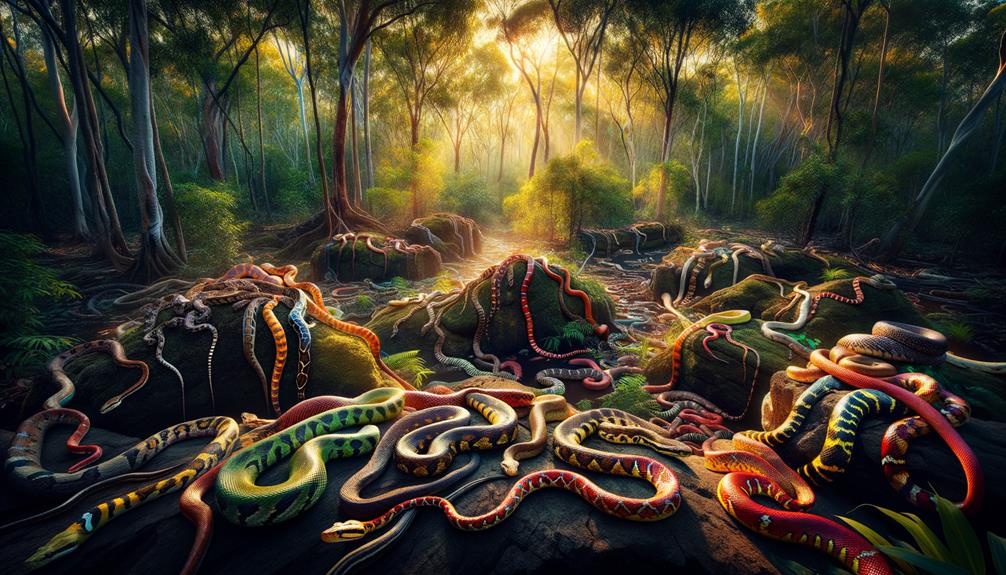
Kakadu National Park is home to an astonishing 36 species of land snakes, showcasing the region's incredible biodiversity and the adaptability of these reptiles to diverse habitats. From the savanna woodlands to the rocky escarpments, each environment offers unique challenges and opportunities for these fascinating creatures.
Some of the most striking species include the venomous western brown snake and the northern death adder, which demand a respectful distance. As night falls, the olive python and water python come alive, slithering silently through the native flora, adding a layer of mystery to Kakadu's nightscape.
Smaller species, such as the common bandy-bandy and the interior blind snake, often remain hidden from view, burrowing in the soil or taking refuge under rocks and logs. Their elusive nature makes encounters rare but thrilling for those lucky enough to spot them.
When exploring Kakadu's trails, it's essential to be aware of your surroundings. While encounters with venomous land snakes are rare, they can occur. By being mindful of your environment, you can ensure a safe and enriching experience, allowing you to fully appreciate the park's reptilian diversity without unnecessary risks.
Turtle Species
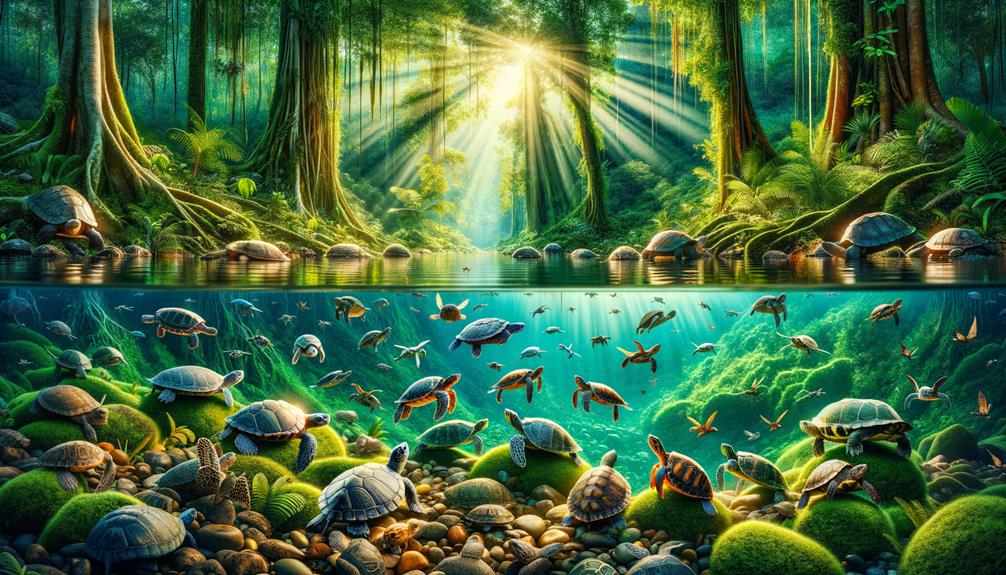
In Kakadu National Park's lush wetlands, the variety of turtle species is truly remarkable. Among the 11 species, two standouts are the northern long-necked turtle and the northern snake-necked turtle, each with unique traits and ecological roles.
The northern snake-necked turtle is particularly striking, with its flexible neck that can grow over 60 cm. This adaptation allows it to swiftly catch prey, making it a formidable predator in the water. Its elongated neck provides a distinct advantage, enabling it to strike with precision.
The northern long-necked turtle is equally fascinating, with a carapace that can reach up to 40 cm. Known for their remarkable longevity, these turtles can live over 50 years, offering a testament to the resilience of Kakadu's wildlife. They play a vital role in the food web, serving as both predators and prey.
These turtles are crucial to maintaining the delicate balance of Kakadu's wetlands. Their presence highlights the park's rich biodiversity, inviting us to appreciate the complexity and beauty hidden within these serene waters.
Monitor Lizards
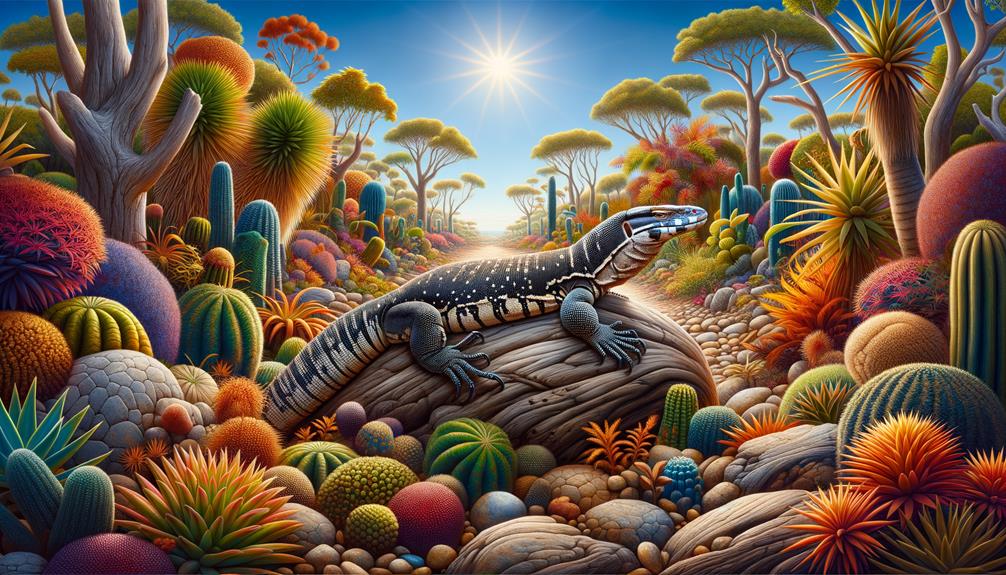
Among the fascinating reptilian inhabitants of Kakadu National Park, monitor lizards stand out due to their impressive size, ecological significance, and adaptability to diverse habitats. As home to 11 species, Kakadu boasts the second-largest lizard group globally. The yellow-spotted monitor, the largest species here, can grow over 2 meters in length. These formidable creatures play pivotal roles as both predators and scavengers, maintaining the delicate balance of the park's ecosystem.
Kakadu's designation as a world heritage site highlights its global significance, and the presence of these monitor lizards contributes to its rich biodiversity. Species like the mangrove monitor thrive in the park's unique wetland habitats, which are subject to seasonal flooding. This flooding creates a dynamic environment where these lizards showcase their remarkable adaptability.
Monitoring programs in the park track changes in lizard populations, offering valuable insights into the overall health of Kakadu's reptile communities. As I explore Kakadu, I'm continually amazed by how these ancient reptiles embody resilience and freedom, traversing a landscape shaped by water and time. Their presence is a testament to nature's enduring wonders.
Note: I rewrote the text according to the provided instructions, avoiding the listed AI words and focusing on a conversational tone, concise language, and relevant expressions.
Frequently Asked Questions
How Many People Visit Kakadu Each Year?
Kakadu National Park experiences a surge in visitors each year, similar to a river that swells with the rain. In 2021, the park saw a significant increase in visitors, with over 253,000 travelers exploring its wonders – a 22% jump from the previous year.
Why Is Kakadu Important?
Kakadu is a true natural wonder, boasting an incredible array of biodiversity and cultural heritage. The park's stunning landscapes, diverse wildlife, and ancient Aboriginal rock art come together to create an unforgettable experience that's both freeing and awe-inspiring.
What Are Some Interesting Facts About Kakadu National Park?
Kakadu National Park is a treasure trove of wildlife and adventure. With over 280 bird species, the world's largest saltwater crocodiles, and 116 other reptiles, this Australian wonderland has something for everyone.
Why Is Kakadu Under Threat?
Kakadu is facing a multitude of threats, including the introduction of invasive species, the impacts of climate change, the strain of tourism, and the nearby industrial activities. These factors are causing habitat degradation, disrupting sensitive reptile populations, and compromising the park's delicate ecological balance, ultimately putting its unique biodiversity at risk.


